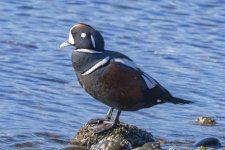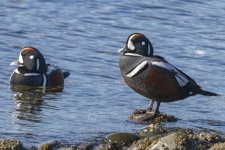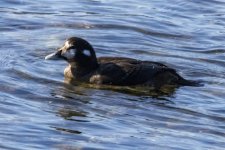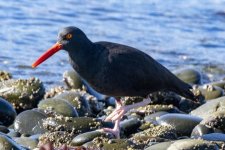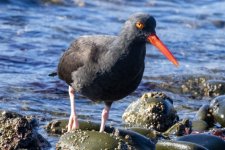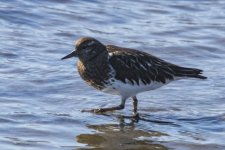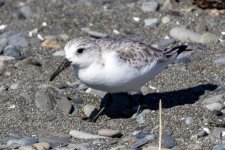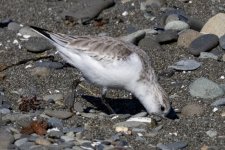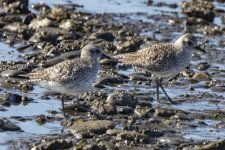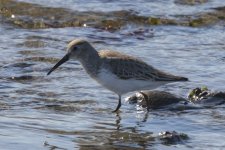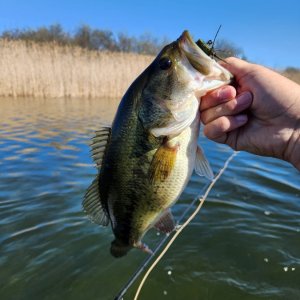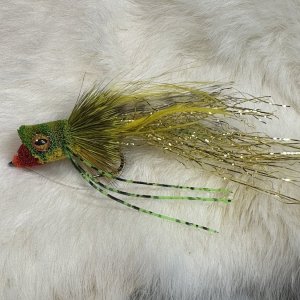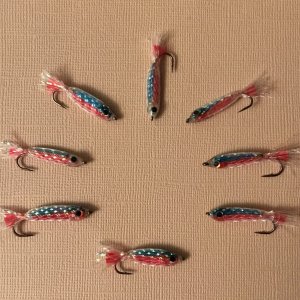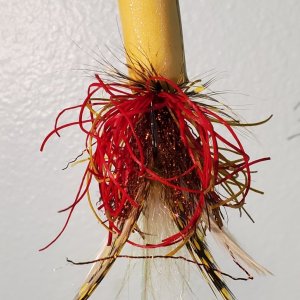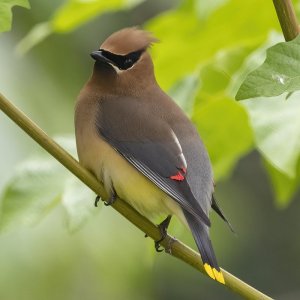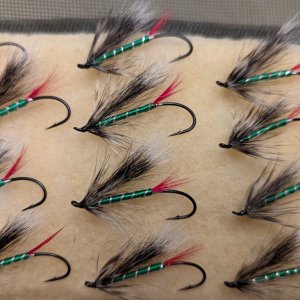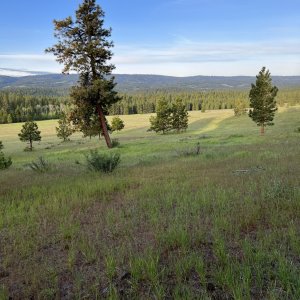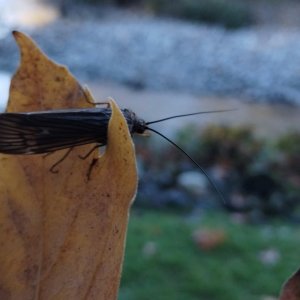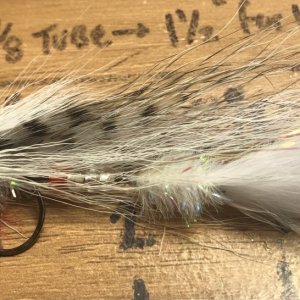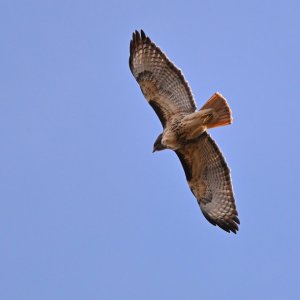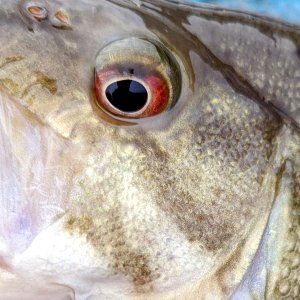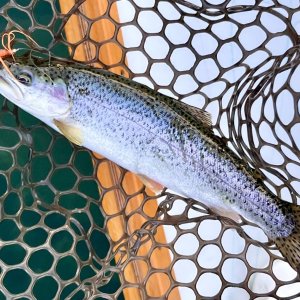Ediz Hook and Three Crabs, 6 March 2022
[Part 1 or 2} The forecast for Sunday was for sunny skies. After a Saturday of staring at computer screens for too long, we needed an escape, an adventure. Armed with a lunch of tasty sandwiches that my wife whipped up, we were off early for the Port Angeles area. We left Olympia under fog but the skies quickly cleared as we wove our way along Hwy. 101 to Ediz Hook.
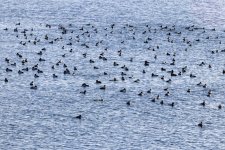
As we zipped along the winding shoreline of Hood Canal, we could see the occasional diving bird near the shore. But we were on a mission and weren’t planning to stop unless something unusual popped up. And it did. We encountered a mixed flock of 100+ diving ducks, mostly greater scaups and surf scoters, north of Hamma Hamma.
They were diving for clams in the productive waters of Hood Canal; there are several shellfish farms along its shores. And based on my photographs, the scaups were quite successful in acquiring clams for breakfast. Apparently, they crush the shells in their muscular gizzards.
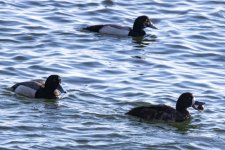
We arrived at Ediz Hook and parked near the tip of the 3-mile spit.
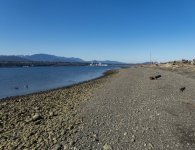
The far end is off-limits as it is a Coast Guard station and just outside the Coast Guard property is the dock and shore facilities for the pilots that guide boats through these busy waters. Ediz Hook consists of a long, narrow, hook-shaped sand bar which protects the port of Port Angeles from waves traveling from the west along the Strait of Juan de Fuca. The spit developed as sediments eroding from the heart of the Olympic Mountains were carried by the Elwha River to the Strait of Juan de Fuca. Waves and tidal currents transported these sediments eastward along the shore and deposited them to create this spit (and the larger longer Dungeness Spit further east)
We arrived shortly before low tide. We did not see much bird activity, either on the sandy beach or offshore on the Strait side of the hook, just surf scoter or two that were diving far offshore. But the protected waters inside of the hook was quite busy. In the bay, double-crested cormorants, common loons, red-necked grebes, and red-breasted mergansers dove for “second breakfast”. While we were there, bull sea lion blasted through deeper into the bay, on a mission it appeared.
The shoreline of the inside of the hook was even busier. The upper shore is dominated by sand and fine gravel and transitions to boulders in the lower intertidal. The most prominent inhabitants was a flock of about 50 brant.
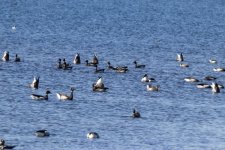
An adult brant is about a third the weight (and half the length) of a Canada goose and about 25% heavier than a mallard.
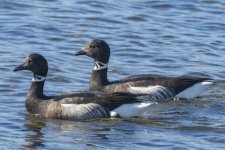
The the birds below appear to be in a "whose necks is longer" contest.
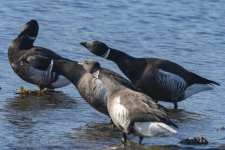
Using the same “tip up” behavior of dabbling ducks, the brants came up with mouthfuls of the green algae Ulva (sea lettuce).
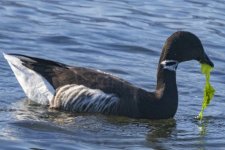
They were not too concerned by us, but they were skittish just the same, probably to the threat of a hungry bald eagle (one of which did fly by while we were there).
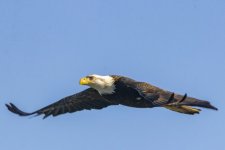
Some cue would spook the whole flock which would burst into flight before returning to the shore to resume feeding.
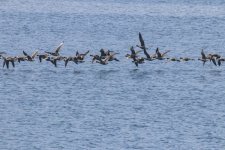
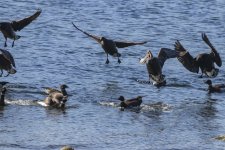
Steve
[Part 1 or 2} The forecast for Sunday was for sunny skies. After a Saturday of staring at computer screens for too long, we needed an escape, an adventure. Armed with a lunch of tasty sandwiches that my wife whipped up, we were off early for the Port Angeles area. We left Olympia under fog but the skies quickly cleared as we wove our way along Hwy. 101 to Ediz Hook.

As we zipped along the winding shoreline of Hood Canal, we could see the occasional diving bird near the shore. But we were on a mission and weren’t planning to stop unless something unusual popped up. And it did. We encountered a mixed flock of 100+ diving ducks, mostly greater scaups and surf scoters, north of Hamma Hamma.
They were diving for clams in the productive waters of Hood Canal; there are several shellfish farms along its shores. And based on my photographs, the scaups were quite successful in acquiring clams for breakfast. Apparently, they crush the shells in their muscular gizzards.

We arrived at Ediz Hook and parked near the tip of the 3-mile spit.

The far end is off-limits as it is a Coast Guard station and just outside the Coast Guard property is the dock and shore facilities for the pilots that guide boats through these busy waters. Ediz Hook consists of a long, narrow, hook-shaped sand bar which protects the port of Port Angeles from waves traveling from the west along the Strait of Juan de Fuca. The spit developed as sediments eroding from the heart of the Olympic Mountains were carried by the Elwha River to the Strait of Juan de Fuca. Waves and tidal currents transported these sediments eastward along the shore and deposited them to create this spit (and the larger longer Dungeness Spit further east)
We arrived shortly before low tide. We did not see much bird activity, either on the sandy beach or offshore on the Strait side of the hook, just surf scoter or two that were diving far offshore. But the protected waters inside of the hook was quite busy. In the bay, double-crested cormorants, common loons, red-necked grebes, and red-breasted mergansers dove for “second breakfast”. While we were there, bull sea lion blasted through deeper into the bay, on a mission it appeared.
The shoreline of the inside of the hook was even busier. The upper shore is dominated by sand and fine gravel and transitions to boulders in the lower intertidal. The most prominent inhabitants was a flock of about 50 brant.

An adult brant is about a third the weight (and half the length) of a Canada goose and about 25% heavier than a mallard.

The the birds below appear to be in a "whose necks is longer" contest.

Using the same “tip up” behavior of dabbling ducks, the brants came up with mouthfuls of the green algae Ulva (sea lettuce).

They were not too concerned by us, but they were skittish just the same, probably to the threat of a hungry bald eagle (one of which did fly by while we were there).

Some cue would spook the whole flock which would burst into flight before returning to the shore to resume feeding.


Steve

